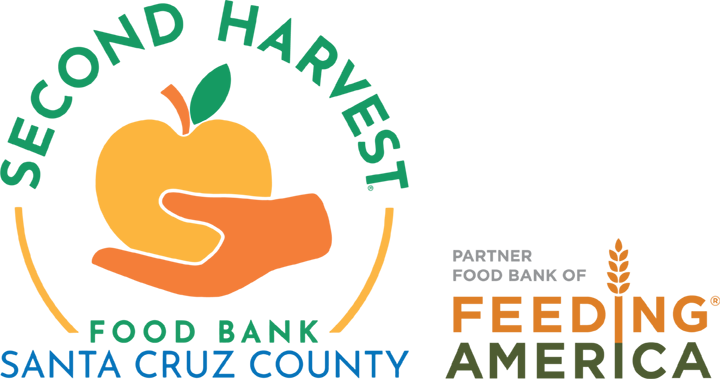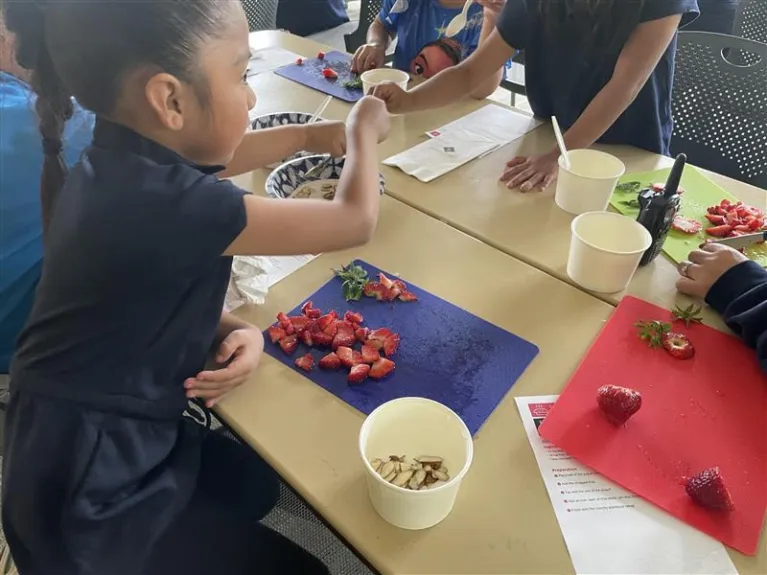Excerpt from Santa Cruz Sentinel
by Tara Fatemi Walker
Does it sound impossible to transform kids who hate blueberries into kids who not only like them, but are willing to use them in a recipe? The Second Harvest Food Bank and the Watsonville Public Library recently collaborated to produce this miracle and more.
Recipe Remix is a Monday afternoon series of four events at the library, two in June and two in July (the last is July 15). Facilitated by Second Harvest staff, each 90-minute program includes nutrition education for kids and “cooking cart demos” where attendees — which sometimes include parents or other family members — get to taste the final products. The series was popular from the start, with 16 kids showing up to the first one.
“The cooking cart demos are effective, because they keep the younger audience engaged,” says Vanessa Arizmendi, Second Harvest’s wellness and nutrition director. “It is a short lesson and a recipe all in 90 minutes.” Arizmendi oversees the nutrition team, composed of Nutrition Education Manager Delia Bernal and Nutrition Education Coordinator Lizzett Sanchez Nol, which does cooking demos, cooking clubs and nutrition classes for the community, and at Second Harvest’s distribution sites.
Sanchez Nol was the instructor for the first Recipe Remix session, where the majority of attendees gave the yogurt parfait recipe two thumbs up. “The kids were very excited,” she says. “Some people don’t realize that involving kids in the kitchen and cooking can teach them many things. In all our recipes, we use fresh fruit and vegetables. This encourages healthy eating because children are open to eating the food they’ve helped prepare.”
For example, Sanchez Nol has repeatedly observed that children come into the classes saying they don’t like blueberries. “After we teach them about the health benefits of blueberries and help them create a fun creative recipe, they will end up not only eating the blueberries but also really enjoying them,” she says. “I love when things like this happen!”
The sessions begin with Sanchez Nol or Bernal spending around 20 minutes on nutrition education covering topics such as “What is a Whole Grain” or “The Importance of a Colorful Plate.” After that, for the next 45 minutes the instructor and group make a hands-on recipe that reinforces what was taught in the nutrition education part of the demo. “For instance, if we (Delia or I) teach a lesson on whole grains we include a recipe about how to incorporate healthy whole grain options in their diet,” she explains.
In addition to teaching, Sanchez Nol is involved in designing and creating nutrition curriculum. “I find my role quite rewarding,” she says. “Aside from playing a crucial part in improving the community’s health and well-being, I get to engage with individuals on a personal level. They share stories about their families as well as the hardships and determinants that affect them reaching optimal health. This is key to providing the best services we possibly can to our community.”
Sanchez Nol says a successful nutrition program is not limited to nutrition education. “Instead, it is paired with a cooking class that aligns with a mission that promotes healthier eating habits, fosters creativity and enhances life skills. I believe that this is why the nutrition program at Second Harvest is successful.”
Delia Bernal led the second Recipe Remix session, with a smoothie recipe featuring bananas, strawberries and blueberries. “The kids really enjoyed cutting and adding the ingredients to the blender. Tasting the final result was one of their favorite parts,” says Bernal. The session also included an activity where participants had to look at images of fruits and vegetables and determine specific health benefits they provide according to their colors.
The roots of Recipe Remix? The library, which had received a grant and recently purchased a cart to do cooking demonstrations, reached out to Second Harvest to see if staff was available to provide cooking demos with a nutrition education component. “I saw this as a great opportunity for us to reach kids over the summer,” says Arizmendi. “The recipes are quick and easy to recreate on their own.”
In the summer, when kids aren’t in school and don’t have access to free or reduced-cost food programs, nutrition is especially important. Some organizations (like the library and Second Harvest) focus on providing options for the students and families. Bernal has enjoyed participating in Recipe Remix and looks forward to future partnerships. “Joining forces is a great way to support each other’s organizations and support the community.”
Bernal is a strong nutrition education advocate. “As a mother and grandmother, I believe any space for our families to gather and prepare food is critical to nurture a family,” she says. “The cooking demonstrations provide great opportunities for the community to experience different approaches to preparing foods that are familiar to them. Inspiring community members about cooking at home and developing their creativity is also part of our mission.”
Cooking cart demos like Recipe Remix are “one-offs” where The Food Bank may or may not see the participants again. Second Harvest also provides year-round nutrition education including “cooking clubs,” which require six-month commitments from attendees. “There is a sequence to the lessons and recipes; together they create a whole experience that builds on each other,” says Arizmendi.
In recent years, the nonprofit began surveying clients annually about its services and asked what types of food people want to see at distributions. “This has yielded more data-driven decision-making around food purchasing and recipes,” says Josue Barajas, Second Harvest chief programs officer. “We learned that more people wanted to learn how to cook and make healthier food choices, so we created cooking clubs to fill the gap. Families can come to these clubs and learn how to make delicious, healthy recipes. At the end of the class, they get to take home a box filled with ingredients to continue practicing at home.”
The clubs are always followed by participant surveys. “I know we’re making an impact when the recipes we introduce are well-received and our participants report in our post-survey that they would cook the recipe at home,” says Arizmendi. “On average, 90% say they would.” Arizmendi takes great pride in the work she and her team accomplish. “We not only help our community with nourishing their food insecurity, but we are also able to give them the tools they need to be successful in cooking with, and trying, new ingredients.”
The last session of Recipe Remix at the Watsonville Library, 275 Main St., is from 1:30-3 p.m. July 15. All ages are welcome.
The Second Harvest Food Bank will hold its inaugural Party in the Parking Lot on Aug. 3. There will be food trucks and a performance by The Joint Chiefs. Go to thefoodbank.org/partyintheparkinglot to learn more.
Recipe
Yogurt parfait
Ingredients
1/2 cup plain Greek yogurt
1/4 cup fruit, chopped
1 tbsp chia seeds (soaked in 1/4 cup water)
1 tbsp your favorite jam
1/4 cup granola or cereal
1 tsp dark chocolate nibs (optional)
Preparation
1. Place half of the yogurt into a small bowl.
2. Add the chopped fruit.
3. Top with the rest of the yogurt.
4. Add an even layer of chia seeds, jam and chocolate nibs.
5. Finish with the crunchy granola or cereal.
Parfait de yogurt
Ingredientes
1/2 taza de yogur natural Griego
1/4 taza de frutas picadas
1 cucharada de Semillas de chía
1 cucharada de mermelada
1/4 taza de granola o cereal
1 cucharadita de chocolate negro fina-mente picado (opcional)
Preparacion
1. En un copa o pequeña bol coloque la mitad del yogur.
2. Adicione la fruta picada.
3. Cubra con el resto de yogur.
4. Añada una capa uniforme de semillas de chía, mermelada y los trocitos de chocolates.
5. Termine añadiendo la crujiente granola o cereal.

